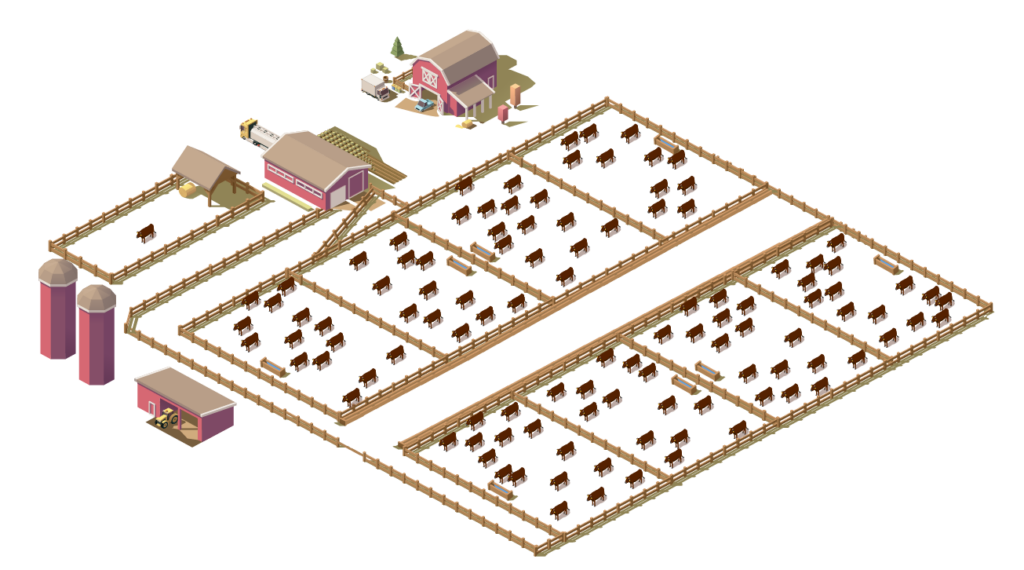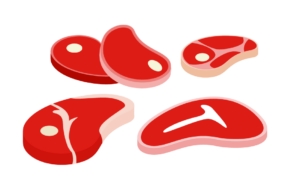On This Page:
Beef Cattle System Elements
Photo by Etienne Girardet on Unsplash
Beef Production Phases
Cow-Calf Ranches
Calves are usually born on cow-calf ranches in the spring, where they spend the first months of their lives on wide open grass pastures with their dams (mother cows). The expanses of natural land used for cattle grazing has both benefits and challenges.


Weaning
Calves are weaned from their dams so that they can be moved to feedlot or backgrounding operations to grow and put on weight. The cows usually remain at the ranch to give birth to the next years’ calves. Depending on the methods used, weaning can be highly stressful for cows, calves, and ranchers.


Sales and Transport
By the end of the summer, calves are usually sold to larger feedlot or backgrounding operations. This is the highest period of stress for the cattle, and the time in which they are most susceptible to infections.


Backgrounding and Feedlot Operations
These high-density operations are equipped to efficiently feed and grow young cattle. However, the combined stresses of weaning, transport, auction, and intermingling with new cattle creates a high risk of infection such as Bovine Respiratory Disease (BRD). To prevent illness, most cattle are given antibiotics upon arrival at the feedlot. This is the stage of production where the most antibiotics are used in the beef cattle industry.


Abattoir and Meat Packing
When cattle have reached target weights, they are transported to an abattoir (slaughterhouse) for processing. A minimum withdrawal period ensures that any antibiotics given to a food animal has been metabolized and/or excreted prior to slaughter. In Canada, there are no antibiotics found in any meat products.


Consumer Demand
Meat products of varying grades and cuts are purchased by wholesalers for exports or local retail. Some of the marketing labels attached to beef products include “organic”, “humane”, “grass fed”, and “hormone free.”
Consumer purchasing decisions drive the entire production chain by creating demand for products with certain features or price-points.

A Note On Dairy Cattle
Since only female cows produce milk, male calves born on dairy farms enter the beef cattle production system. At the end of their lives, female cows also become beef cows. Although milk production is a unique industry, several the technologies and innovations apply to both beef cattle and dairy cattle.

Cattle Terms
Bull
Calf
Cow
Heifer
Yearling
Dam
Sire
An uncastrated male bovine animal.
A bovine animal under one year of age.
A mature female bovine animal that has produced a calf.
A female bovine animal that has not yet produced a calf.
A calf between one and two years old.
A female parent of an animal (mother).
A male parent of an animal (father).
Video Resources
It tells the story of the collective effort that is needed to ensure food stays safe, animals stay healthy, and livelihoods continue to prosper. This project began by investigating the difficulties and hardships of change, while exploring ways producers and the veterinary community could work together to fight antimicrobial resistance.
What the filmmakers discovered was an industry of stewards who are already collaborating, innovating, and actively changing their practices, to protect the safety and sustainability of the food we eat, and this is the story that Raised With Care: Stewards of the Land tells.
References
[1] Government of Canada, ‘Analysis of the beef supply chain’, Jul. 29, 2021. https://www150.statcan.gc.ca/n1/pub/18-001-x/18-001-x2021002-eng.htm (accessed Aug. 23, 2022).
[2] Canadian Beef, ‘Canada Beef Fast Fact Sheet’. Jun. 2021. Accessed: Aug. 23, 2022. [Online]. Available: https://canadabeef.ca/wp-content/uploads/2021/09/Canada-Beef-Fast-Fact-Sheet-2021.pdf
[3] Jelinski MD, Kennedy R, Campbell JR. Demographics of the Canadian cow-calf industry for the period 1991 to 2011. Can Vet J. 2015 Feb;56(2):163-8. PMID: 25694666; PMCID: PMC4298269. Available: https://www.ncbi.nlm.nih.gov/pmc/articles/PMC4298269/

